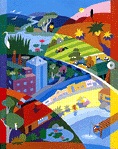
Food, Health, Farms

"If we forget that packaged eggs or hamburgers came from animals,
a cotton shirt from a plant, a wooden chair from a tree, then we have
lost that connection with nature."
Professor David Suzuki, Geneticist and Writer

Food, Health, Farms

"If we forget that packaged eggs or hamburgers came from
animals,
a cotton shirt from a plant, a wooden chair from a tree, then we have
lost that connection with nature."
Professor David Suzuki, Geneticist and Writer
| Bushfood The fledgling Australian bushfoods industry is now exploring new ingredients based on Australia's native plant and animal biodiversity, gathered and prepared for thousands of years by indigenous Australians. Tangy Quandongs and buttery Macadamia nuts come from the rainforests; aromatic Lemon Myrtle from our woodlands; Pepperleaf and berries from the southern highlands, and spicy bush tomatoes from the desert, to mention a few. Health A quick look in your bathroom cabinet will reveal many medicines that rely on biodiversity. Everything from aspirins to antibiotics to Eucalyptus oil were derived from living organisms. Biodiversity provides many useful substances for fighting human diseases. Aspirin for example, is based on a chemical from the willow tree. Morphine comes from opium poppies. Quinine, used for 300 years to treat malaria, comes from the bark of the yellow cinchona plant. Over 21,000 plants around the world have reported medicinal uses. Farms The grazing and agricultural lands that cover almost three quarters of Australia are also a living resource of biodiversity and need to be managed to protect it. Without the natural biodiversity which lives in rural ecosystems there would be less soil formation, nutrient cycling, natural water purification and pollination of crops. This section of my environment web site is based upon a booklet produced by the Department of the Environment and Heritage, Environment Australia. This material can be freely reproduced for non-commercial purposes provided Environment Australia is acknowledged. Their logo appears at the bottom of this page. |
Now take a tour of my Biodiversity Web.
![]() 20 Ways to Protect Biodiversity
20 Ways to Protect Biodiversity
![]() In the Backyard and Beyond
In the Backyard and Beyond
![]() On Holiday and on the Water
On Holiday and on the Water
![]() Warning: Signs of Change
Warning: Signs of Change
![]() Links and Resources
Links and Resources
![]() Biodiversity Home Page
Biodiversity Home Page
![]() Back to the Environment
Site Map
Back to the Environment
Site Map
![]() E-mail me
E-mail me
Biodiversity material from:
